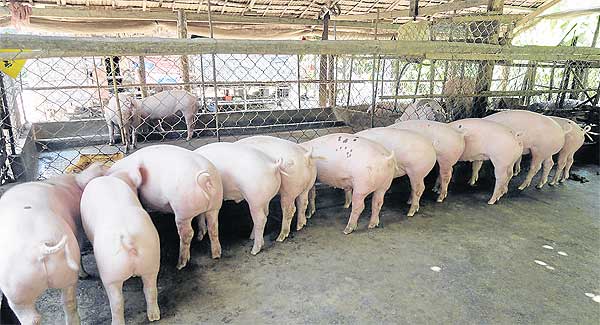- Published: 1/10/2012
- Bangkok Post
- Writer: Philip Heijmans
Cambodians like pork. The average Cambodian
consumes 9.29 kilogrammes of the meat a year and local farmers have long
supplemented their incomes by selling an average of two pigs a year.
 Cambodian pig prices are down 5% but feed costs are up 25%. As well,
Thai firms use hormones and only need to feed pigs for three months
instead of six.
Cambodian pig prices are down 5% but feed costs are up 25%. As well,
Thai firms use hormones and only need to feed pigs for three months
instead of six.
In 2008, Cambodian farmers supplied around 2 million pigs, more than
90% of domestic demand. But the market for small-scale pig farmers is
vanishing. Most of the pork local people now eat is imported from
Thailand, or comes from large-scale producers who have seized the market
once dominated by local farmers.
Though bad for the farmers, the changes have been good for consumers:
live pig prices have fallen 53.5% to about 7,000 riel (53 baht) per
kilogramme in just one year, pork industry executives say.
Since last year, about 30% of all subsistence pig farmers have called
it quits, and if the government is unable to stem the flood of cheap
pork from Thailand, they will be completely wiped out in five years,
said Prathna Preap, a swine market expert at the USAID-funded micro,
small and medium enterprise strengthening project.
“Our local pigs sell for cheaper and cheaper prices because of all
the importing happening now,” said Lim Oun, a 45-year-old farmer in
Kandal province, adding that he could get 8,000 riel per kg of live pig,
a 5% drop since the start of the month.
To make matters worse, feeding pigs is increasingly expensive, as
feed costs have risen 25% to 2,500 riel, or 21 baht, per kg, said Mr
Preap. Feed constituted 80% of the production cost among subsistence pig
farmers last year, according to USAID data.
Mr Oun accused the Thai pig exporters of using hormones that increase
the size of pigs twice as fast as their counterparts in Cambodia, which
are raised on feed only. Because of the chemicals, Mr Oun said, the
Thai produces are “only raising them for three months and spend less
money on feed that we invest over six months”.
Since Thailand lifted its moratorium on pig exports to Cambodia in
September 2011, Thai producers are now bringing in half of the country’s
estimated consumption of 6,000 pigs per day at a rate below production
cost — a form of dumping, said Mr Preap.
Where most developed countries have safeguards to protect local
industries from dumping practices, Cambodia does not. A draft law is in
front of the Council of Ministers but experts question whether it would
be enforced if it passes.
Without the law, Cambodia’s industries are at the mercy of foreign dumping practices.
Such was the case in 2010, when China and Vietnam allegedly sold
shoes in Cambodia well below costs, cutting into the profits of local
factories.
“Aside from pork consumers, those benefiting from the cheap prices
the most are the traders and butchers since there are only a limited
number licensed slaughterhouses, where there are a huge number of pig
raisers,” said Mr Preap.
And with subsistence pig raisers on the way out, corporate processors
such as M’s Pig ACMA (Cambodia) Co. Ltd, 91% owned by the local
conglomerate Mong Reththy Group Co Ltd, are claiming stakes. According
to the Mong Reththy website, it plans 16 commercial farms and 15 feed
mills and four slaughterhouses able to fill 35-38% of the market’s total
demand by 2015.
The other large player is Thailand’s gigantic Charoen Pokphand (CP)
Group. It has pig and poultry feedmills and livestock farming plants in
the country worth a total $37.22 million, according to its 2011
financial report, but pig production numbers were not available.
“The pigs
[produced by the companies] are better quality than those of the
local farmers because of better breeding, hygiene and feeding practices,
making the meat leaner,” said Mr Preap. “Companies have also begun
delivering the pigs to slaughterhouses directly, where before, pig
collectors would have to come to the villages to buy them.”
In fact, local corporate swine operations have more than doubled in
capacity over the past year and have gone from holding only a minor
stake in the market to supplying 33-50% of the total market, producing
2,000 to 3,000 pigs a day, he said.
Srun Pov, president of the Cambodian Pig Raisers Association, said
that without an anti-dumping law, it is up to the companies to provide
quality pork and stabilise prices.
“I think that if they can produce enough local pigs then it would be a
good thing since we would stop importing from Thailand. I don’t think
those companies can produce enough though,” he said.
The local conglomerate Bivol Bopha (BVB) is one company that believes
it can. It aims to double the number of pigs it produces to 100 by
November at its farm in Kompong Thom province, said farming manager Ky
Chanarith.
“Our farm is growing and we hope later to include pigs from local
farms as well. This way the business does not affect them,” he said.
But it is too late for that, said Mr Preap.

No comments:
Post a Comment